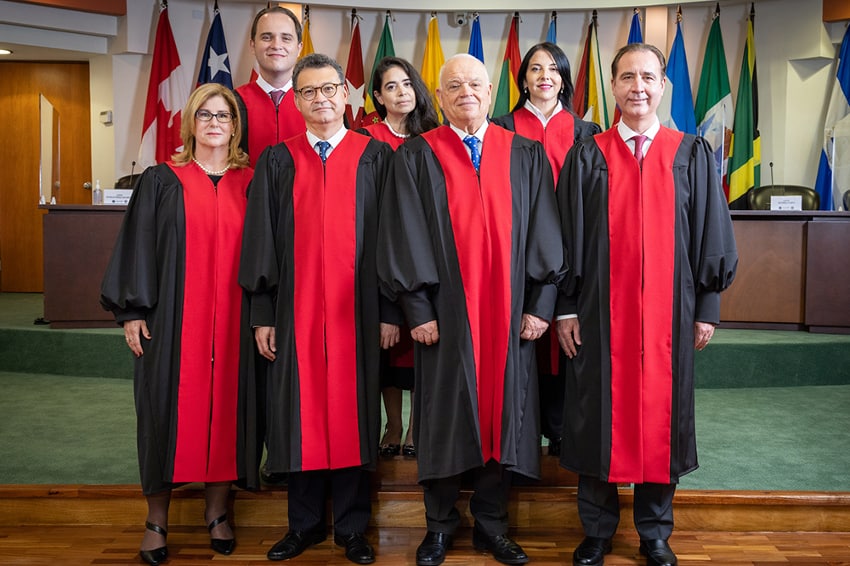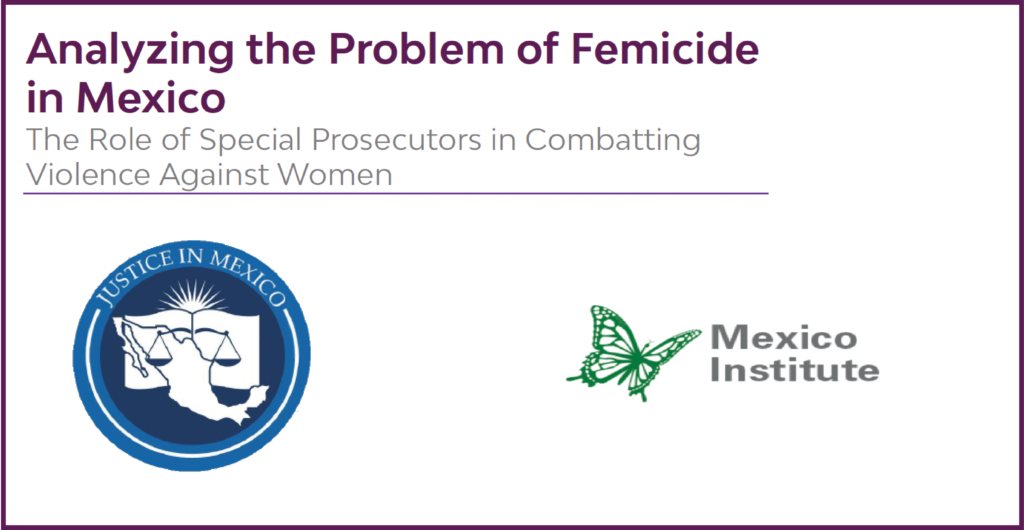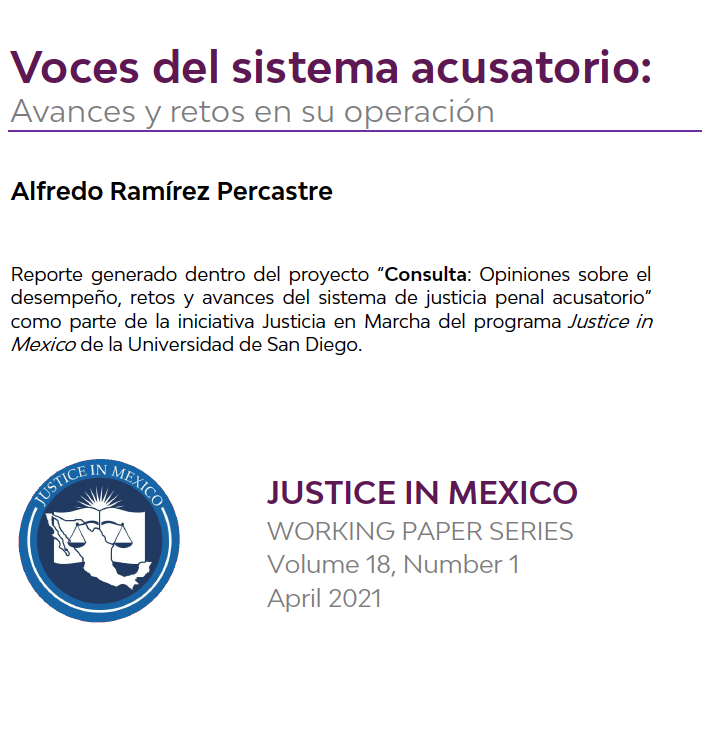02/10/21 – The following work is an investigative piece by Justice in Mexico Training Coordinator Janice Deaton.
Introduction
The COVID-19 pandemic has disrupted all sectors of society in Mexico, including its criminal justice system. Judicial powers throughout the country, which administer the state and federal justice systems, have had to modernize with new and updated technologies as they migrate to digital administration of justice. Many envision the potential of digital justice to broaden access to justice, but caution against further exclusion and marginalization of vulnerable groups.
Closure of Mexican Judicial Powers
On March 17, 2020, Mexico’s Health Secretary (Secretaría de Salud) issued an order closing all non-essential government offices, including the courts. The administration of justice in Mexico came to a standstill. Hearings were postponed with the expectation to resume them when conditions allowed and the pandemic ended. As weeks turned into months with no end in sight, however, judicial powers had to balance public health and safety with fundamental legal rights. This led to an acceleration of digital administration of justice, for which some states were more prepared than others.
Many state judicial powers initially relied on remote technology such as videoconference to resolve matters not requiring hearings or in-person appearances. In-person hearings were held for only the most urgent of matters, such as domestic violence and evictions. In the criminal justice system, defendants remained in custody, awaiting resolution in their cases.
Some States Are More Prepared than Others
On August 10, 2020, courts throughout the country reopened to a backlog of cases. Social distancing and other conditions of the pandemic required the judicial powers of each state to incorporate some form of technology in their administration of justice. Some states such as Nuevo León, Aguascalientes, and the State of Mexico, were able to accelerate the transition to digital administration of justice because they had already been using the technology in other facets of the administration of justice. For example, the judicial power in Nuevo León implemented electronic filing of legal forms and remote hearings in 2016. In May 2020, the judicial power in Nuevo León opened its “Virtual Courthouse” to the public, with an instructional video on YouTube. In 2018, the State of Mexico implemented its virtual court by employing electronic signatures and resolving certain disputes on-line. The Coahuila Judicial Power (Poder Judicial del Estado de Coahuila de Zaragoza) set up an electronic mailbox on its website to accept legal documents or forms 24 hours a day. Its implementation was completed on August 17, 2020.
As of August 2020, six months into the pandemic, the federal judicial power and 21 state judicial powers were holding hearings through videoconference. However, in criminal matters, only Nuevo León and Coahuila provided remote public access to hearings, raising concerns of public access to hearings (publicidad). Although there has been progress, there is still no national uniformity in the administration of justice or public access to justice during the pandemic.
The technologically-advanced judicial powers of some states have been assisting other states that are new to digital justice. For example, when the judicial power in Jalisco initiated its virtual justice program in July 2020, judicial powers in Nuevo Leon, Aguascalientes, and the State of Mexico provided assistance.
In spite of good progress, there remains a lack of uniform implementation of digital justice as judicial powers continue to await an over-due National Code of Civil Procedure. This resulting lack of coordination between the federal judiciary and the 32 states and entities is paramount among the challenges of digital justice.
Current and Pending Legislation
On March 18, 2014, the Mexican legislature issued a National Code of Criminal Procedure (Código Nacional de Procedimientos Penales , CNPP) that applies in federal cases throughout Mexico, as well as in each state and Mexico City. Article 51 of the CNPP provides for the use of digital technologies in criminal justice, including videoconferences. Three years later, the September 15, 2017, constitutional reform provided the Mexican legislature would draft a national, unified code of family law and civil procedure, whose ambit would include legal standards, norms, and procedures for the digital administration of justice. Congress agreed that, during the following 180 days during which time it would draft a new code, the current code would remain in place.
In spite of Congress’s agreement to draft and approve a new, unified code of family law and civil procedure in 2017, it has not yet happened. This code will establish rules and standards for digital justice nationally. In the meantime, states are prohibited from issuing their own codes, rules, or regulations in the interim period because, as the Supreme Court of Mexico (Suprema Corte de Justicia de la Nación, SCJN) has held on two occasions, this would invade the exclusive purview of Congress. This leaves the state judicial powers unable to ensure their use of digital technology is in compliance with yet-unknown standards on appeal.
Constitutional reform proposals have been brought to the floors of Congress. On June 3, 2020, the president of the Justice Commission in the House of Representatives, Pilar Ortega, along with Representative Janet Melanie Murillo Chávez, presented an Initiative for a National Code of Civil Procedure to the floor. While the Ortega bill mentions digital or electronic administration of justice, it does not provide standards or norms.
Senator Ricardo Monreal Ávila proposed a different constitutional reform on July 8, 2020. According to the MORENA party (Movimiento Regeneración Nacional), Senator Monreal’s proposal specifically addresses digital platforms, and attempts to provide easy access to digital justice, through the use of information and communication technologies.
These are not the only proposals being considered. Congress is currently evaluating over 24 constitutional reform initiatives to ensure justice administrated through digital platforms conforms with Mexican constitutional and human rights standards. Additionally, the Federal Judicial Council (Consejo de la Judicatura Federal, CJF), which oversees and administers the federal judicial branch, (excluding the Supreme Court of Justice and the Electoral Court) has issued several General Agreements regulating the integration of electronic files and the use of videoconferences in federal jurisdiction. In June 2020, it issued General Agreement 12/2020, with criteria for the use of video conferences and electronic filing in all federal matters, including criminal justice. This does not negate the need for a new civil procedure code, however. There will not be uniform guidelines or norms governing this crucial area of law until a new civil procedure code is legislated and passed for state judicial powers.
Creativity, Patience, and Thinking Outside the Box
Academics, think tanks, civil society organizations, and judicial operators have attempted to fill gaps in legal standards and norms by producing webinars, and writing guides or manuals to aid judicial powers as well as litigants and judges. Judicial operators generally agree digital administration of justice requires flexibility, creativity, and patience. They agree vast disparities in resources throughout the country, from access to infrastructure and the internet, to the consumer power to purchase the tools required for such access, require new approaches to justice. As retired Supreme Court Justice José Ramón Cossío stated, “We are not building a utopia (…) We must think about how we bring the greatest number of tools to the greatest number of people, to resolve the greatest number of conflicts in the best possible way.” (“No estamos construyendo una utopía (…) Debemos pensar cómo acercamos el mayor número de herramientas al mayor número de personas, para resolver el mayor número de conflictos de la mejor manera posible.” Translation by author)
In Chile, Leonardo Moreno, an instructor and senior researcher with Justice in Mexico’s OASIS project, co-authored a manual, “Technology, Criminal Process, Hearings and Oral Trial.” It was published in collaboration with Alberto Hurtado University (Universidad Alberto Hurtado) and CEJA (Justice Studies Center of the Americas, Centro de Estudios de Justicia de las Américas), on June 6, 2020. The manual offers a broad approach to justice administration during the pandemic, and emphasizes flexibility and creativity. The authors suggest varied approaches to case management, from rescheduling hearings where defendants are not in custody, to holding remote hearings where possible. There might be cases that are processed in a hybrid manner, with certain witnesses appearing in-person and others remotely. Where internet is not available, telephones can be used as long as it is possible to confidently identify the witness.
The think tank México Evalúa is a leader in the study of the use of technology in the administration of justice. In October 2020, building on their long-term research project on digital justice, México Evalúa published its “Guide to Good Practice on the Use of New Technologies in the Administration of Justice” (available here in English and Spanish.) The manual focuses on the potential of technology to broaden access to justice while checking its capacity to further marginalize vulnerable groups. It also provides good policy practices for judiciaries or judicial powers, as digital justice becomes a permanent part of Mexican justice. The guide concludes with recommendations for the judicial powers, based on its case studies and research. As Laurence Pantin, the Coordinator of the Transparency in Justice project at México Evalúa says in her introduction to the manual, “Our intention is to offer a referential guide … to the various dilemmas that judiciaries face when they promote the use of new technologies, not only to expand access to justice, but also to make proceedings more efficient, faster and/or less costly or, ultimately, to guarantee the service of remote administration of justice under the circumstances we find ourselves in this year.”
Newspapers and opinion writers have also weighed in. In his editorial for El Universal, Miguel Carbonell offers various ways digital justice can save time and resources, including providing direct public access to legal forms, streamlining certain processes and lowering legal costs. He also highlighted four tools each judicial power needs in order to implement digital administration of justice. These include: access to file complaint or initial filings, with availability 24 hours a day; electronic filing system available to litigants; telephonic or videoconference hearings; electronic signatures; and a reduction of “red tape.”
OASIS’s Contribution
On July 29, 2020, Justice in Mexico’s OASIS project presented a webinar on fundamental rights in the administration of justice during the pandemic. Three OASIS instructors, from Chile, Mexico, and the United States, presented challenges and successes in the administration of justice in their respective countries since the COVID-19 pandemic began.
Jesus Romero, from San Diego, California, said the closure of courts is denying fundamental rights to defendants, especially those who are detained pretrial. Mr. Romero mentioned several potential rights violations, including the Confrontation Clause of the Sixth Amendment. In the United States, the right to confront witnesses means confront in person, with face-to-face cross examination. Confronting witnesses or the accused via video or the internet would violate the Sixth Amendment rights of the defendant.
Mr. Romero explained that the California judicial system has made various adjustments in response to the pandemic, including allowing money-based bail to be eliminated in certain cases.
Leonardo Moreno, from Santiago, Chile, explained there are some hearings and cases that can easily be resolved remotely, without the need for any in-person hearings. With trials or more complicated hearings, Mr. Moreno emphasized the need for legal standards covering the admission of evidence, use of prior statements to impeach or refresh recollection, and other litigation tools typically used.
Iker Ibarreche, from Mexico City,agreed the lack of uniform code or regulations governing digital administration of justice is a paramount challenge. Mr. Ibarreche said each state is proceeding based on procedures it believes comply with the federal constitution, creating as many approaches to justice during the pandemic as there are states in the Republic of Mexico. This makes it difficult for litigants to prepare for hearings since the requirements change, depending on which jurisdiction a case is under. Further, this lack of a uniform code means there is no assurance that the cases will be upheld or affirmed on appeal. Thus, when the cases arrive in front of the federal tribunals or the Supreme Court, Mr. Ibarreche continued, they might be reversed on appeal and result in a “waste of time.”
All three presenters agreed on the need for litigants and parties to conduct themselves ethically, and testify in accordance with the law without notes or coaching from others. This is even more true with the use of videoconferences where it is difficult to monitor all conduct off-screen. OASIS is now working in collaboration with the American Bar Association’s Rule of Law Initiative (ABA ROLI) to publish a practical, hands-on manual on best practices in digital justice for litigants and judges. The manual will address the challenges and successes litigants and judges have encountered during digital hearings. This includes minimum technological requirements; proper use of cameras and microphones; the use of exhibits and prior declarations; the regulation of witness behavior, and other issues. OASIS expects to publish the manual in the Spring of 2021.
Conclusion
Mexico is undergoing a modernization of its judicial system that is here to stay. Justice system operators envision digital justice to positively transform Mexican system of justice, making it more accessible and user friendly for the nation’s citizens. If so, Mexican citizens will find their judicial system more accessible and more user-friendly, which would in turn lead to a stronger judicial institution.
Sources
El Informador staff. Ponen Ejemplo A Jalisco Con Juzgados Virtuales. El Informador. August 11, 2020.
Garcia, Claudia Ivett, La Primavera Mexicana de la Justicia Digital, El Economista. Sept. 3, 2020.
Pantin, Laurence. How to Resume the Administration of Justice, México Evalúa. May 15, 2020.
Pantin, Laurence. No Hay Vuelta Atrás Para La Justicia Digital. México Evalúa. June 18, 2020.
Poder Judicial Ciudad de México. Información Covid-19. (Last visited January 10, 2020.)




